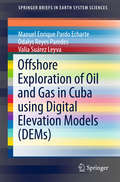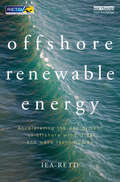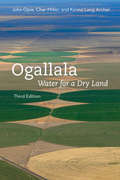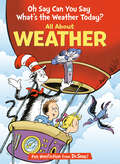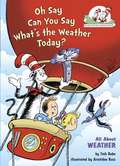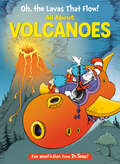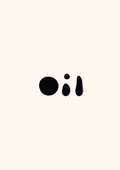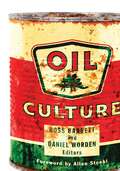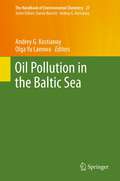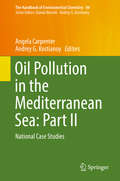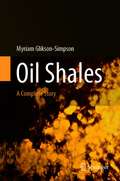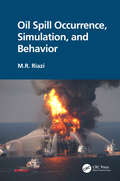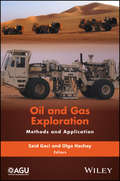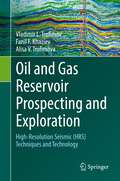- Table View
- List View
Offshore Exploration of Oil and Gas in Cuba using Digital Elevation Models (SpringerBriefs in Earth System Sciences)
by Manuel Enrique Pardo Echarte Odalys Reyes Paredes Valia Suárez LeyvaThis book provides an overview of the major changes induced by hydrocarbons (HCs) affecting rocks and surface sediments and their implications for non-seismic exploration methods, particularly for marine territories near Cuba. It examines the use of a digital elevation model (DEM) at 90x90m resolution for the detection of subtle, positive geomorphic anomalies related to hydrocarbon microseepage (vertical migration) on possible oil and gas targets. The results support the conclusion that the DEM data provides a low cost and fast offshore oil and gas preliminary exploration strategy. This data is useful serving to focus prospective areas with supplementary unconventional methods such as magnetic-induced polarization (MIP), useful to propose more expensive volumes for detailed 2D–3D seismic surveys.
Offshore Renewable Energy: Accelerating the Deployment of Offshore Wind, Tidal, and Wave Technologies
by Iea-Retd (Stichting Foundation RenewableWave, tidal and offshore wind technologies have long held the promise of seemingly limitless energy supplies. In practice, while offshore wind is growing relatively rapidly, all three sectors have lagged behind expectations. This book, from the International Energy Authority Renewable Energy Technology Deployment implementing agreement (IEA-RETD), examines the reasons for this and suggests how barriers to deployment might be overcome. Beginning with an assessment of the marine energy resource, it provides a detailed introduction to the main technologies currently being employed to harness wind, tidal and offshore wind power. It then examines the types of policies which are used to encourage deployment around the world, and progress towards meeting targets. The economics of offshore energy projects are discussed, along with risks that projects face and the types of finance which are available. A final section turns to barriers - both technical and non-technical (including environmental, health and safety, skill related, supply chain and more) - and in all cases suggests how to mitigate and remove these barriers. Highly illustrated in full colour, this is an indispensable resource for anyone - whether in industry, policy or academia - looking to learn more about how deployment of offshore renewable energy technologies can be encouraged.
Offsite Production and Manufacturing for Innovative Construction: People, Process and Technology
by Jack S. Goulding Farzad Pour RahimianThe offsite and modular market is continuing to grow. This book builds on the success of a number of initiatives, including formative findings from literature, research and development and practice-based evidence (success stories). It presents new thinking and direction from leading experts in the fields of: design, process, construction, engineering, manufacturing, logistics, robotics, delivery platforms, business and transformational strategies, change management, legislation, organisational learning, software design, innovation and biomimetics. This book is particularly novel and timely, as it brings together a number of cogent subjects under one collective ‘umbrella’. Each of these chapters contain original findings, all of which culminate in three 'Key Learning Points' which provide new insight into the cross-cutting themes, interrelationships and symbiotic forces that exist between each of these chapters. This approach also provides readers with new contextualised understanding of the wider issues affecting the offsite market, from the need to embrace societal challenges, through to the development of rich value-laden solutions required for creating sector resilience. Content includes a balance between case studies and practice-based work, through to technical topics, theoretical propositions, pioneering research and future offsite opportunities ready for exploitation. This work includes: stakeholder integration, skills acquisition, new business models and processes, circularity and sustainable business strategies, robotics and automation, innovation and change, lean production methodologies and new construction methods, Design for Manufacturing and Assembly, scaled portfolio platforms and customisability, new legal regulatory standards and conformance issues and offsite feasibility scenario development/integration.
Ogallala, Third Edition: Water for a Dry Land (Our Sustainable Future)
by Char Miller John Opie Kenna Lang ArcherThe Ogallala aquifer, a vast underground water reserve extending from South Dakota through Texas, is the product of eons of accumulated glacial melts, ancient Rocky Mountain snowmelts, and rainfall, all percolating slowly through gravel beds hundreds of feet thick.Ogallala: Water for a Dry Land is an environmental history and historical geography that tells the story of human defiance and human commitment within the Ogallala region. It describes the Great Plains’ natural resources, the history of settlement and dryland farming, and the remarkable irrigation technologies that have industrialized farming in the region. This newly updated third edition discusses three main issues: long-term drought and its implications, the efforts of several key groundwater management districts to regulate the aquifer, and T. Boone Pickens’s failed effort to capture water from the aquifer to supply major Texas urban areas. This edition also describes the fierce independence of Texas ranchers and farmers who reject any governmental or bureaucratic intervention in their use of water, and it updates information about the impact of climate change on the aquifer and agriculture.
Ogden Dunes
by Dick Meister Historical Society of Ogden Dunes Ken MartinOgden Dunes, incorporated in 1925, is the largest and most residential of the three Porter County lake-front communities established in the 1920s. Although it began as a highly restricted resort community with the largest man-made ski jump in North America, it became a middle-class residential community after 1945. Because of its proximity to Gary and Chicago, Ogden Dunes was also a battleground between the forces that wished to conserve the dunes and those that pushed for industrializing them. Alice Gray, Diana of the Dunes; Dorothy Buell, who led the fight to create a national park; and Dale Messick, the creator of comic strip Brenda Starr: Girl Reporter were important members of the community. Over the years, Ogden Dunes has provided a creative and supportive environment for children and adults, especially those with artistic talents and interests.
Oglebay Park
by Brent CarneyIn 1926, Earl Oglebay willed his summer estate, Waddington Farm, to the city of Wheeling with the hope that it would provide entertainment and education to the community. He and naturalist A.B. Brooks, both mavericks in ecology and agricultural training, established the unique environmental emphasis still evident in the park's nature center, trails, Discovery Lab, and zoo. The 1,650-acre municipal park nestled in the Wheeling hills also features Wilson Lodge, the premier hotel in the area, and 49 log cabins that pay tribute to the community's storied frontier past. The cabins and the Pine Room Pool were built in the 1930s by the Civilian Conservation Corps. Those brave young men, along with a famous golf course architect, Bob Biery, created the Oglebay Caddy Camp, which has been featured in several major golf magazines. Today, Oglebay Park hosts festivals, legendary jazz bands, and top-notch equestrian events. The park's Winter Festival of Lights is considered to be the nation's largest light show.
Oh Say Can You Say What's the Weather Today? All About Weather: All About Weather (The Cat in the Hat's Learning Library)
by Tish RabeLaugh and learn with fun facts about the sun, thunderstorms, snowflakes, and more—all told in Dr. Seuss&’s beloved rhyming style and starring the Cat in the Hat! &“You see, weather keeps changing, but one thing we know. It makes life exciting wherever you go.&” The Cat in the Hat&’s Learning Library series combines beloved characters, engaging rhymes, and Seussian illustrations to introduce children to non-fiction topics from the real world! Look up in the sky and learn: • how to read a weather map• what the water cycle is• how meteorologists forecast the weather• and much more! Perfect for story time and for the youngest readers, Oh Say Can You Say What's the Weather Today? All About Weather also includes an index, glossary, and suggestions for further learning. Look for more books in the Cat in the Hat&’s Learning Library series!If I Ran the Horse Show: All About HorsesClam-I-Am! All About the BeachMiles and Miles of Reptiles: All About ReptilesA Whale of a Tale! All About Porpoises, Dolphins, and WhalesSafari, So Good! All About African WildlifeThere's a Map on My Lap! All About MapsOh, the Lavas That Flow! All About VolcanoesOut of Sight Till Tonight! All About Nocturnal AnimalsWhat Cat Is That? All About CatsOnce upon a Mastodon: All About Prehistoric MammalsThe Cat on the Mat: All About Mindfulness
Oh Say Can You Say What's the Weather Today?: All About Weather (Cat in the Hat's Learning Library)
by Aristides Ruiz Tish RabeThe Cat and company travel by hot air balloon up and into various weather phenomena including rain, snow, thunder, tornadoes, and (yikes!) even hurricanes! Along the way they learn about thermometers, anemometers, wind vanes, cloud formations, humidity, fog, smog, weather folklore, and how to stay safe in lightning. Written and illustrated in Seussian style, this a great addition to the Cat in the Hat’s Learning Library!
Oh, the Lavas That Flow! All About Volcanoes (The Cat in the Hat's Learning Library)
by Todd TarpleyLaugh and learn with fun facts about hot lava, ash clouds, volcanos, and more—all told in Dr. Seuss&’s beloved rhyming style and starring the Cat in the Hat!&“I&’m the Cat in the Hat, and I&’m here to explain-o some marvelous facts all about the volcano!&” The Cat in the Hat&’s Learning Library series combines beloved characters, engaging rhymes, and Seussian illustrations to introduce children to non-fiction topics from the real world! Erupt with laughter while you discover:• how most volcanoes are underwater• what the difference between lava and magma is• how volcanoes help create rain and new land• and much more!Perfect for story time and for the youngest readers, Oh, the Lavas That Flow! All About Volcanoes also includes an index, glossary, and suggestions for further learning. Look for more books in the Cat in the Hat&’s Learning Library series!If I Ran the Horse Show: All About HorsesClam-I-Am! All About the BeachMiles and Miles of Reptiles: All About ReptilesA Whale of a Tale! All About Porpoises, Dolphins, and WhalesSafari, So Good! All About African WildlifeThere's a Map on My Lap! All About MapsOut of Sight Till Tonight! All About Nocturnal AnimalsWhat Cat Is That? All About CatsOnce upon a Mastodon: All About Prehistoric MammalsOh Say Can You Say What's the Weather Today? All About WeatherThe Cat on the Mat: All About Mindfulness
Ohio Science: A Closer Look [Grade 4]
by Jay K. Hackett Richard H. Moyer Joanne VasquezScience text: Ohio Edition, Grade 4
Oil
by Matthew YeomansMatthew Yeomans begins his investigation into the role of oil in America by trying to spend a day without oil--only to stumble before exiting the bathroom (petroleum products play a role in shampoo, shaving cream, deodorant, and contact lenses). When Oil was published in cloth last year, it was quickly recognized as the wittiest and most accessible guide to the product that drives the U.S. economy and undergirds global conflict. The book sparked reviews and editorials across the country from the Wall Street Journal, the Christian Science Monitor, and The Nation to Newsday , the San Francisco Chronicle, Wired and others. Author Michael Klare (Blood and Oil) called it "a clear, comprehensive overview of the U.S. oil industry . . . in one compact and highly readable volume," and Boldtype praised Yeomans's "crisp journalistic voice. . . . Understanding the business of oil is essential in any modern dialog of power, politics, or the almighty buck, and Yeomans delivers a well-researched and gripping read."Illustrated with maps and graphics--and now with an all-new afterword--Oil contains a brief history of gasoline, an analysis of the American consumer's love affair with the automobile, and a political anatomy of the global oil industry, including its troubled relationship with oil-rich but democracy-poor countries.
Oil Beach: How Toxic Infrastructure Threatens Life in the Ports of Los Angeles and Beyond
by Christina Dunbar-HesterCan the stories of bananas, whales, sea birds, and otters teach us to reconsider the seaport as a place of ecological violence, tied to oil, capital, and trade? San Pedro Bay, which contains the contiguous Ports of Los Angeles and Long Beach, is a significant site for petroleum shipping and refining as well as one of the largest container shipping ports in the world—some forty percent of containerized imports to the United States pass through this so-called America’s Port. It is also ecologically rich. Built atop a land- and waterscape of vital importance to wildlife, the heavily industrialized Los Angeles Harbor contains estuarial wetlands, the LA River mouth, and a marine ecology where colder and warmer Pacific Ocean waters meet. In this compelling interdisciplinary investigation, award-winning author Christina Dunbar-Hester explores the complex relationships among commerce, empire, environment, and the nonhuman life forms of San Pedro Bay over the last fifty years—a period coinciding with the era of modern environmental regulation in the United States. The LA port complex is not simply a local site, Dunbar-Hester argues, but a node in a network that enables the continued expansion of capitalism, propelling trade as it drives the extraction of natural resources, labor violations, pollution, and other harms. Focusing specifically on cetaceans, bananas, sea birds, and otters whose lives are intertwined with the vitality of the port complex itself, Oil Beach reveals how logistics infrastructure threatens ecologies as it circulates goods and capital—and helps us to consider a future where the accumulation of life and the accumulation of capital are not in violent tension.
Oil Culture
by Daniel Worden Ross BarrettIn the 150 years since the birth of the petroleum industry oil has saturated our culture, fueling our cars and wars, our economy and policies. But just as thoroughly, culture saturates oil. So what exactly is &“oil culture&”? This book pursues an answer through petrocapitalism&’s history in literature, film, fine art, wartime propaganda, and museum displays. Investigating cultural discourses that have taken shape around oil, these essays compose the first sustained attempt to understand how petroleum has suffused the Western imagination.The contributors to this volume examine the oil culture nexus, beginning with the whale oil culture it replaced and analyzing literature and films such as Giant, Sundown, Bernardo Bertolucci&’s La Via del Petrolio, and Ben Okri&’s &“What the Tapster Saw&”; corporate art, museum installations, and contemporary photography; and in apocalyptic visions of environmental disaster and science fiction. By considering oil as both a natural resource and a trope, the authors show how oil&’s dominance is part of culture rather than an economic or physical necessity. Oil Culture sees beyond oil capitalism to alternative modes of energy production and consumption.Contributors: Georgiana Banita, U of Bamberg; Frederick Buell, Queens College; Gerry Canavan, Marquette U; Melanie Doherty, Wesleyan College; Sarah Frohardt-Lane, Ripon College, Matthew T. Huber, Syracuse U; Dolly Jørgensen, Umeå U; Stephanie LeMenager, U of Oregon; Hanna Musiol, Northeastern U; Chad H. Parker, U of Louisiana at Lafayette; Ruth Salvaggio, U of North Carolina, Chapel Hill; Heidi Scott, Florida International U; Imre Szeman, U of Alberta; Michael Watts, U of California, Berkeley; Jennifer Wenzel, Columbia University; Sheena Wilson, U of Alberta; Rochelle Raineri Zuck, U of Minnesota Duluth; Catherine Zuromskis, U of New Mexico.
Oil Panic and the Global Crisis
by Steven M. GorelickIs the world running out of oil? This book analyzes predictions of global oil depletion in the context of science, history, and economics.There has been continuing alarm about the imminent exhaustion of earth's non-renewable resources. Yet, the world has never run out of any significant, globally traded, non-renewable resource. Is the world finally facing a non-renewable resource depletion catastrophe, or is the current concern just another one of a succession of panics? In this book, key assumptions and underlying arguments in the global oil-depletion debate are first summarized and then challenged. Facts about oil supply, production, and consumption are made accessible using concise and simple graphics.Concepts of resource depletion, end-use needs, technology leap-frogging, efficiency, and substitution are used to evaluate historical patterns of exploitation of non-renewable resources and to explore what history suggests about our future dependence on oil.This book is aimed at a broad range of readers,from undergraduate students studying resource science and economics to anyone interested in understanding the context of the controversy over global oil depletion."It is a book serious students of the world oil market should read, not because Gorelick has all the answers but because his account is well reasoned, well informed, and argued honestly, with respect for responsible opposing viewpoints."Book Review, Science, May 2010
Oil Pollution Control
by Sonia M. ZaideOil pollution has been a major environmental concern since the 1920s. The search for a solution has ranged from prevention to partial measures coupled with compensation and remedial action. This book, originally published in 1987, offers a different assessment of the efforts of governments and the oil and maritime industries. It was also the first book to provide a comprehensive story of control policies and practices, using primary and secondary sources. The book identified numerous factor – personalities, state policies, developments in the oil and shipping industries, public agitation and scientific studies in a framework useful for analysing any environmental problem.
Oil Pollution in the Baltic Sea
by Andrey G. Kostianoy Olga Yu LavrovaThis thorough review is based on observational satellite, airborne and in-situ data, scientific literature and technical reports, as well as the substantial experience of the authors, who hail from several Baltic Sea countries. They pay special attention to national practices, HELCOM and EMSA CleanSeaNet activities in oil pollution monitoring, and show different applications of the Seatrack Web model for oil spill drift prediction and the identification of illegal polluters, as well as for environmental risk assessment. Furthermore, some of the results on satellite monitoring of the Nord Stream gas pipeline construction in the Gulf of Finland are presented. This volume addresses the needs of specialists working in different fields of marine, environmental, and remote sensing sciences. It is a useful handbook on oil pollution for international and governmental agencies, as well as for policy makers who plan and manage oil and gas projects, the construction of ports and terminals, shipping, fishery, recreation, and tourist activities in the Baltic Sea. It also offers graduate and undergraduate students in marine and environmental sciences a valuable resource and reference work on the subject.
Oil Pollution in the Mediterranean Sea: National Case Studies (The Handbook of Environmental Chemistry #84)
by Andrey G. Kostianoy Angela CarpenterThis volume reviews the oil inputs to the Mediterranean Sea from sources such as shipping, offshore oil installations, and oil refineries, presented in a number of national case studies. A regional overview is also presented for the Adriatic Sea. Topics include mapping of oil slicks in the Adriatic, oil exploration and exploitation activities in the waters of the Levantine Basin (Eastern Mediterranean), the oil pollution preparedness and response activities of individual Mediterranean states, bilateral and regional cooperation among the various states, and the risk of pollution from shipping in sensitive sea areas, for example. Together with the companion volume Oil Pollution in the Mediterranean Sea: Part I - The International Context, it addresses both national and international measures in the region, making it of relevance to the agencies and government bodies tasked with remediating or preventing oil pollution, as well as policymakers and practitioners in the fields of shipping, ports and terminals, oil extraction and marine management. It provides researchers with essential reference material on tools and techniques for monitoring oil pollution, and constitutes a valuable resource for undergraduate and post-graduate students in the field of marine oil pollution.
Oil Rig Roughneck (Cool Adventure Careers)
by Geoffrey M. HornThe first group of titles in an ongoing series introduces students to six amazing adventure careers. Geared for reluctant readers in upper elementary school and above, each high-interest title combines easy-to-follow text with engaging on-the-job photos to spark students' interest in reading and career exploration. Each book is filled with descriptive information about the career, along with the skills and requirements needed to pursue a job in the profiled field.
Oil Rig and Superbarge Floating Settlements (Lecture Notes in Civil Engineering #82)
by Joseph LimThis book presents a collection of proposed offshore and nearshore settlements in response to the emerging consequences of climate change. These settlements are counterpoints to megacities with unsustainable ecological footprints. The continuing depletion of natural resources has resulted in displaced communities, prompting the following research questions: What if we floated on sea instead of inefficiently consuming land? Could we use wave energy instead of nuclear energy? How can we replenish food supply and regenerate marine eco-diversity? How would our lives be shaped by new offshore settlements? What would we use as structures for shelter, farming, scaffolding and recreation? Floating cities emerged in the 1960s with Buckminster Fuller’s Triton City and Kenzo Tange’s Tokyo Bay Plan, and current manifestations include Vincent Callebaut’s Lilypad, the Seasteading Institute and the mile-long Freedom Ship housing 50,000 people. As an alternative to these examples, the book proposes the repurposing of three types of marine vessel: jack-up platforms, semi-submersibles and superbarges as sustainable, habitable structures to accommodate 20% of the projected 8.1 billion global population in 2025. The spatially conceived floating settlements include food and energy supplies for housing, recreation, education at sea, post-disaster health care and resettlement for nearshore deployment.
Oil Shales: A Complete Story
by Miryam Glikson-SimpsonThis book provides thorough knowledge and detailed information of oil shales using a range of conventional and unconventional techniques and methodologies combined to elucidate the composition of oil shale deposits. As these rocks are mined for energy production their composition and mineral constituents are of special interests to individuals and communities that are likely to be effected by these resources when mined and processed. The book highlights the environmental and health hazards of the spent shales after processing. These are significantly greater in volume than the rocks originally mined before processing. Toxic metals tend to double and triple their concentrations in the spent shales and will be leached into water sources and soils.Since oil shales as an energy resource are totally uneconomical; all oil shales, their mining and processing are heavily subsidised by governments and institutions using taxpayers money.
Oil Spill Dispersants: Efficacy and Effects
by National Research Council of the National AcademiesApproximately 3 million gallons of oil or refined petroleum products are spilled into U.S. waters every year. Oil dispersants (chemical agents such as surfactants, solvents, and other compounds) are used to reduce the effect of oil spills by changing the chemical and physical properties of the oil. By enhancing the amount of oil that physically mixes into the water, dispersants can reduce the potential that a surface slick will contaminate shoreline habitats. Although called for in the Oil Pollution Act of 1990 as a tool for minimizing the impact of oil spills, the use of chemical dispersants has long been controversial. This book reviews the adequacy of existing information and ongoing research regarding the effectiveness of dispersants as an oil spill response technique, as well as the effect of dispersed oil on marine and coastal ecosystems. Oil Spill Dispersants also includes recommended steps for policy makers faced with making hard choices regarding the use of dispersants as part of spill contingency planning efforts or during actual spills.
Oil Spill Occurrence, Simulation, and Behavior (Fuels and Petrochemicals)
by M.R. RiaziOil Spill Occurrence, Simulation, and Behavior provides practical insight into oil spills and their causes, impacts, response and cleanup methods, simple and advanced modeling of oil spill behavior, and oil spill simulation techniques. Discusses various sources of oil spills and major accidents Includes case studies on the 2010 Gulf of Mexico oil spill, including environmental, economic, and political impacts, modeling and behavior as well as response and cleanup methods Introduces some commercial softwares on predicting oil movement and spreading on water Describes properties and characteristics of crude oil and its products needed for simulation and prediction of behavior of an oil slick Written as an applied book with minimal math and theory, making it accessible to a wide range of readers The book includes more than 100 unique and informative images in color This essential book is aimed at professionals, academics, and scientists in the fields of chemical engineering, petroleum engineering, environmental engineering, marine and ocean engineering working on the simulation and modeling, mitigation, and prevention of oil spills.
Oil and Gas Exploration: Methods and Application
by Olga Hachay Said GaciOil and Gas Exploration: Methods and Application presents a summary of new results related to oil and gas prospecting that are useful for theoreticians and practical professionals. The study of oil and gas complexes and intrusions occurring in sedimentary basins is crucial for identifying the location of oil and gas fields and for making accurate predictions on oil findings. Volume highlights include: Advanced geophysical techniques for achieving hydrocarbon exploration efficiency from beneath the Earth Discussion of theoretical and practical approaches in solving problems related to exploring and mining new oil and gas deposits New geological concepts for predicting potential hydrocarbon targets Novel methods of control of the outworking of these deposits using different geophysical methods, significant for optimization of mining hydrocarbon and carbonate deposits Estimation of the degree of outworking of oil and gas deposits, to facilitate the use of space-time monitoring of different kinds of fields Analysis of exploration data by an efficient processing system, based on strong methods proven mathematically Oil and Gas Exploration is a valuable resource for exploration geophysicists, petroleum engineers, geoengineers, petrologists, mining engineers, and economic geologists, who will gain insights into exploring new methods involved in finding natural resources from our Earth.
Oil and Gas Reservoir Prospecting and Exploration: High-Resolution Seismic (HRS) techniques and technology
by Vladimir L. Trofimov Fanil F. Khaziev Alisa V. TrofimovaThis book discusses topical issues of detailed seismic data interpretation using high-resolution seismic (HRS) techniques, which are based on the numerical method developed by the authors for solving the inverse dynamic seismic problem (IDSP). The authors highlight the range of issues related to the development and application of HRS-Geo technologies on a variety of seismic data, and analyze a significant amount of practical material in various seismic and geological conditions. This analysis allows for the accurate estimation of geological indicators in sediments that are most important for the prediction and exploration of oil and gas deposits, including lithological composition, reservoir properties, and the nature and degree of reservoir rock saturation with fluids. The book is intended for professionals involved in seismic data processing and geological interpretation, students of geophysical and geological specialties, graduate students of these specializations.
Oil and National Identity in the Kurdistan Region of Iraq: Conflicts at the Frontier of Petro-Capitalism (Routledge Studies of the Extractive Industries and Sustainable Development)
by Alessandro TintiExamining the interplay between the oil economy and identity politics using the Kurdistan Region of Iraq as a case study, this book tells the untold story of how extractivism in the Kurdish autonomous region is interwoven in a mosaic of territorial disputes, simmering ethnic tensions, dynastic rule, party allegiances, crony patronage, and divergent visions about nature. Since the ousting of Saddam Hussein, the de-facto borders of the Kurdistan Region of Iraq have repeatedly changed, with energy interests playing a major role in such processes of territorialisation. However, relatively little research exists on the topic. This book provides a timely, empirical analysis of the intersections between extractive industries, oil imaginaries, and identity formation in one of the most coveted energy frontiers worldwide. It shines a light on relations between the global production networks of petro-capitalism and extractive localities. Besides the strained federal relationship with the Iraqi central government, the transformative effects the petroleum industry has had on Kurdish society are also explored in depth. Moreover, the book fills a gap in the literature on Kurdish Studies, which has devoted scant attention to energy-related issues in the re-imagination of Kurdish self-determination. This book will be of great interest to students and scholars of the extractive industries, energy studies, conflict studies, Middle Eastern politics, and political ecology.
